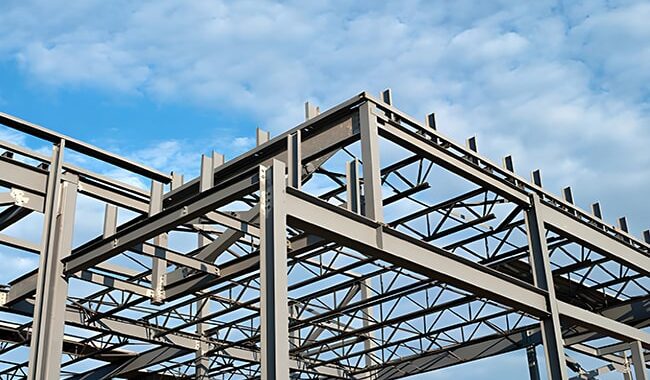A steel frame is a structure made of steel, usually connected by welding, bolting, or riveting steel beams, columns, bracing,…
The modern business climate is more challenging than ever. Worldwide competition, razor-thin margins, and acute labor shortages are a few of the myriad factors affecting industrial enterprises’ profitability. To give your business a head start, developing a strategic industrial layout well-suited for ongoing performance is crucial. Keep reading as we break down five essential factors in developing your industrial infrastructure.

5 Essential Factors in Developing The Industrial Infrastructure
Passive Sustainability Features
Energy efficiency and sustainability are primary considerations for industrial facilities. Government and industry-wide sustainability standards are tightening, and a more conscientious consumer base is choosing to support only those enterprises that do their part in protecting the planet. As such, eco-friendliness is a matter of survival in the contemporary business landscape.
While solar panels, energy-efficient appliances, and smart thermostat features are advanced means of establishing energy efficiency, passive building design should be the first place to start.
What is passive design?
It is a means of designing a building to ensure the site provides as much natural heating, cooling, ventilation, and lighting as possible. Orientation guarantees that the building receives as much natural daylight as possible. Local topography, such as shade trees and bodies of water, can provide natural cooling benefits. Modern architectural louvers allow the passage of fresh air while blocking out water, debris, and pests for optimal ventilation—thermal insulation shields against radical ambient temperatures for more stable interior environments.
Scalability
Scalability issues are among the most insidious threats to a business’s success. Many companies wake up one day and realize they have gotten too big for their current infrastructure to continue supporting profitability. In most cases, there is no cost-effective way to get the business back to scale, leading to disastrous consequences.
Regarding industrial building infrastructure, it is paramount to keep scalability in mind during every step of the design process. The building system must be able to gracefully and efficiently adapt and expand in response to increased growth/demand without sacrificing the performance, reliability, or cost-effectiveness of the enterprise.
The best way to achieve this is by designing versatile, customizable structures that adapt to emerging business needs. Steel buildings are one of the best construction types in this regard. They are incredibly durable and offer vast amounts of interior clear span for efficient interior configuration. In addition, they come in easy-to-assemble prefabricated kits that can be taken down, transported, and expanded to help meet emergent needs.
Noise Mitigation
Commercial facilities can get quite noisy. Constant machine traffic, product fabrication, and industrial heating/cooling can create a distracting din for building occupants. If the noise levels are loud enough, they may threaten ear health.
Therefore, comprehensive noise mitigation throughout the building is crucial. Install acoustic wall panels and ceiling clouds to prevent noise transfer throughout open areas. Use a commercial generator enclosure to ensure that industrial power sources do not create a deafening roar. Consider sound dampers for HVAC ducts. Erect decorative screen panels and architectural grilles around the building’s facade to mitigate noise from precipitation or blowing debris.
Strategic Location
Location is crucial for ensuring the most passive building possible and for facilitating operational success.
Buildings closer to suppliers and customers are better positioned to accommodate fluctuating demand. This has become apparent in the recent e-commerce boom, with businesses increasingly prioritizing mobile fulfillment centers closer to their client base.
Enterprises should also consider macroeconomic conditions before building on a site. Is the local population likely to grow? Is it a desirable job market? These factors will directly impact the long-term viability of the industrial business.
Dynamic Transportation Layout
Modern industrial facilities must be able to accommodate heavy, diverse transportation.
Commercial delivery and transportation needs are more significant than ever. Many businesses even have to outsource, partnering with third-party logistics firms and independent couriers to meet delivery demands. As such, wider loading bays and access roads are essential for staging orders and accommodating a constant flow of delivery vehicles.
Also, ensure viable access for employees, guests, and patrons. Build a robust parking lot that enhances the professional aspect of the business. Permeable pavers are becoming a favorite material in place of asphalt and concrete, thanks to their low maintenance properties and ongoing aesthetics. Consider including EV charging stations in your lot to accommodate the more widespread adoption of electric vehicles. Have parking areas specially designed for bikes, electric scooters, and other environmentally-conscious forms of transportation.
Go Next-Level When Designing Your Industrial Infrastructure
The modern commercial landscape is more challenging than ever. Businesses have to get creative to attain a profit and promote ongoing viability. Considering the five pro tips listed above, you can create an industrial infrastructure that gives your business a leg up on the competition. For more ideas on how prefabricated steel buildings can provide the ideal solution for your industrial building needs, contact Havit Steel Structure today for a consultation!














